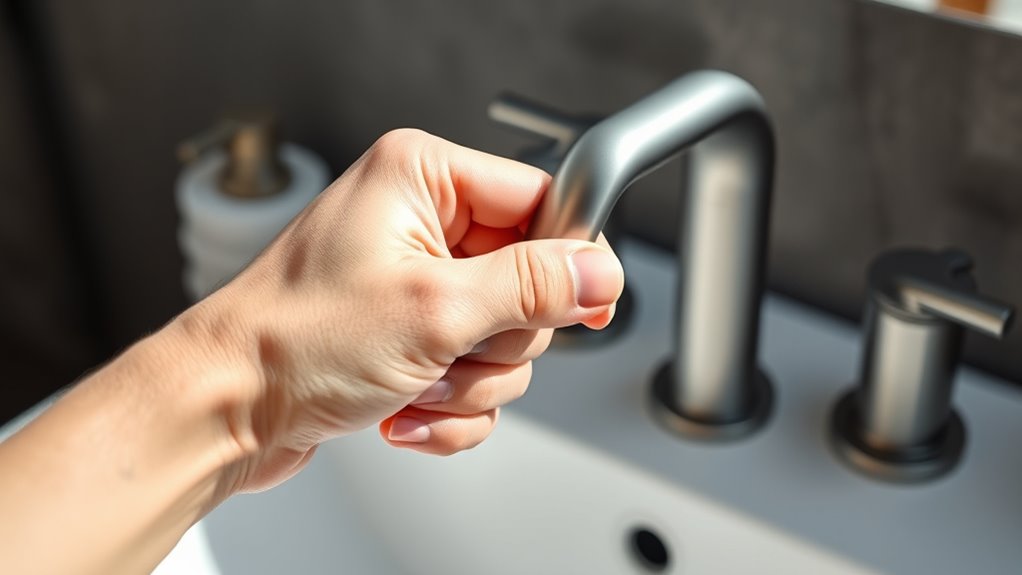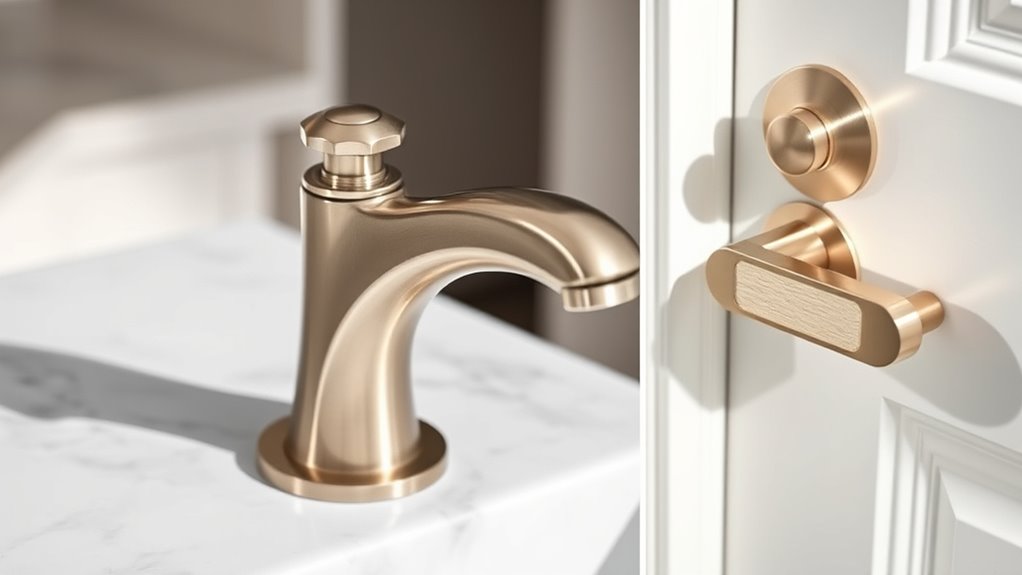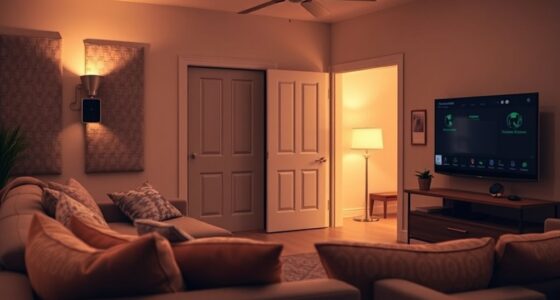Arthritis-friendly hardware, like lever handles and ergonomic fixtures, makes daily tasks easier and safer for you. Lever handles require less grip strength and are easier to turn than traditional knobs, reducing joint strain. Faucets with push-button or touchless features also lessen the effort needed. These designs help you maintain independence and prevent discomfort. Keep exploring to discover more options that can boost comfort and safety around your home.
Key Takeaways
- Lever handles require less grip strength and are easier to operate than traditional knobs, ideal for arthritis sufferers.
- Ergonomic faucets with touchless or push-button controls reduce twisting and gripping efforts, enhancing safety.
- Adaptive hardware features like large, curved levers improve comfort and control for users with limited hand strength.
- Using ergonomic fixtures minimizes joint strain, decreasing pain and preventing further joint deterioration.
- Modern, stylish arthritis-friendly hardware promotes independence and safety in daily tasks at home.

Living with arthritis can make everyday tasks challenging, especially when it comes to using hardware tools. Tasks you once did effortlessly now require extra effort, patience, and sometimes, specialized equipment. That’s where adaptive design and ergonomic tools come into play. These innovations are crafted to make daily routines easier and safer, reducing strain on your joints and improving your overall quality of life. When selecting hardware like lever handles and faucets, choosing those designed with these principles can make a considerable difference.
Adaptive design focuses on creating products that accommodate a wide range of users, including those with limited hand strength or dexterity. For example, lever handles are a popular choice because they require less grip strength than traditional round knobs. Instead of twisting or pinching, you simply push or pull the lever, which can be easier on sore or stiff joints. These handles are often larger and easier to grasp, giving you better control without exerting unnecessary force. Additionally, ergonomic design considers how the product fits naturally in your hand, further reducing discomfort and fatigue. When you opt for hardware with ergonomic features, you’re ensuring that the design conforms to the natural shape of your hand and minimizes discomfort. Ergonomic tools are shaped to reduce strain and improve leverage, making daily tasks less painful and more manageable. Incorporating adaptive and ergonomic features into your home fixtures can significantly enhance comfort and independence. Using ergonomic designs can also help prevent further joint deterioration by promoting healthier movement patterns. Moreover, many of these adaptive features are now integrated with modern technology, offering even greater assistance for users with arthritis.
Lever handles require less grip strength, making daily tasks easier and reducing joint strain.
Faucets with lever handles exemplify adaptive design. They allow you to turn the water on and off with a simple push or pull, eliminating the need for twisting motions that can aggravate arthritis. Some models even feature longer or padded levers to improve grip comfort. Installing these fixtures in your kitchen or bathroom can considerably cut down the effort needed to operate them, especially if you experience stiffness or weakness. Additionally, look for faucets with touchless or single-handle operation, which further reduce the need for gripping and twisting. These features help you maintain independence and prevent unnecessary joint strain.
Beyond faucets and handles, many hardware tools and fixtures now incorporate adaptive and ergonomic designs to assist those with arthritis. For instance, door handles made with large, curved levers are easier to operate than traditional knobs. Shower controls with easy-to-press buttons or levers also help minimize discomfort. When you choose hardware that emphasizes adaptive design, you’re investing in solutions that prioritize your comfort and independence. These products are not only functional but also promote safety by reducing the risk of slips or strains caused by exerting excessive force. Incorporating ergonomic features into your home fixtures can also contribute to a more stylish and modern look, blending form with function seamlessly.
Incorporating ergonomic tools and adaptive design into your home isn’t just about convenience—it’s about empowering you to live more comfortably. By selecting hardware that’s designed with your needs in mind, you can navigate daily tasks with less pain and frustration. Whether it’s a lever handle, a user-friendly faucet, or another adaptive fixture, these choices can make a noticeable difference in your daily life. Additionally, regular use of mammography and other screening methods can help detect health issues early, further supporting your overall well-being.
Frequently Asked Questions
Are Arthritis-Friendly Fixtures Costlier Than Standard Hardware?
You might wonder if arthritis-friendly fixtures cost more than standard hardware. Pricing comparisons show that these accessibility enhancements often come at a slightly higher price, but they’re usually affordable and worth the investment. The extra cost reflects the ergonomic design and ease of use. Ultimately, healthier, easier-to-operate fixtures can improve daily comfort and independence, making the small price difference worthwhile for many who need arthritis-friendly features.
How Do I Choose the Best Lever Handle for My Needs?
Did you know that 85% of people find lever handles easier to use than knobs? When choosing the best lever handle, prioritize an ergonomic grip that reduces strain. Consider whether a lever or knob suits your needs—levers are generally easier to operate with limited hand strength. Look for smooth, easy-to-turn handles with non-slip surfaces to make sure of comfort and safety. Your choice should make daily tasks simpler and more comfortable.
Can Arthritis-Friendly Faucets Be Installed Easily by Homeowners?
Installing arthritis-friendly faucets can be straightforward if you consider installation challenges and design considerations. As a homeowner, you might find these faucets easier to install than traditional ones, especially if the design features simplified connections or clear instructions. However, make certain you have basic tools and follow manufacturer guidelines carefully. If you’re unsure, consulting a professional can help address any installation challenges and ensure your faucet suits your needs.
What Maintenance Is Required for Arthritis-Friendly Hardware?
Ever wondered how much upkeep arthritis-friendly hardware needs? Maintenance is simple; regular cleaning tips involve wiping with a damp cloth and avoiding harsh chemicals. Check replacement guidelines periodically to guarantee smooth operation, especially if handles become stiff or leaky. You don’t need extensive tools or expertise—just a little routine care keeps your hardware functioning well and extends its lifespan. Isn’t it worth a little effort for easier daily use?
Are There Specific Brands Known for Quality Arthritis-Friendly Fixtures?
When choosing fixtures, you look for brands with a strong reputation for quality and reliability. Trusted brands like Moen, Delta, and Kohler are known for their material durability and innovative designs that accommodate arthritis needs. These brands often use high-quality materials that withstand daily use, ensuring long-lasting performance. By selecting reputable brands, you’re investing in fixtures that are not only arthritis-friendly but also dependable and easy to maintain over time.
Conclusion
Choosing arthritis-friendly hardware like lever handles and easy-to-use faucets can transform your daily routine from a struggle into a breeze. These thoughtful adaptations aren’t just about convenience—they’re about reclaiming your independence and comfort. Imagine a world where simple actions no longer cause pain. Isn’t it time you took control and made your home a sanctuary of ease? Embrace these solutions and turn everyday tasks into moments of empowerment and relief.









